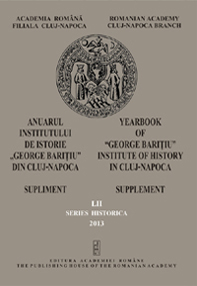Cărţi liturgice şi de pietate în parohiile Eparhiei greco-catolice de Oradea Mare (1850-1900)
Liturgical and Piety Books in the Greek Catholic Parishes of Oradea Mare/Nagyvárad Diocese (1850-1900)
Author(s): Silviu SanaSubject(s): History
Published by: Editura Academiei Române
Keywords: Greek-Catholic; Orthodox; old books; Cyrillic alphabet; piety literature; prayers; Oradea;
Summary/Abstract: After the Union with the Roman-Catholic Church, the Romanian Greek-Catholics used in parallel, not only the old Orthodox books of worship published in Râmnic and Bucharest, but also the Greek-Catholic ones, published in Blaj and Buda. We note the fact that, in the 19th century, the Greek-Catholic parishes have used those of Orthodox provenance, much less numerically, in parallel with the Greek-Catholic ones printed in the printing house from Blaj, their purchase being made by private initiatives (priest, teacher, community) or by the churches. Almost until the end of the 19th century, books of worship printed with Cyrillic alphabet were used, those with Latin alphabet being used by parishes in the last two decades of that century. The use of those with Cyrillic alphabet is proven by the event, property and religious notes present on them. Removing the books written with Cyrillic alphabet and their replacement with those printed with Latin alphabet was a long and lasting process caused, on one hand, by the editorial policy of the ecclesiastical institution, which only in 1872 regulated the printing of all the religious books written with Latin alphabet and, on the other hand, due to the rural mentality, quite unwilling to change, especially since the new editions of the „Litourgicon” from 1870 and the „Epistle Book” from 1878, adopted new formulas, excessively Romanized, which is another reason for their acceptance with a dose of restraint. In addition, one must also take into account the financial situation of the poor parishes, that could not afford to purchase the new books printed by the printing house from Blaj, using the ones they held. Regarding the piety literature, in the second half of the 19th century, the Greek-Catholics used the old devotions of Byzantine tradition (Chapel of Virgin Mary and various Akathists) that were in the books of worship along with the new printed works strictly focused on the believer`s piety and religiosity. These private initiatives, printed in the printing houses from Gherla, Satu Mare, Baia Mare, Sibiu, are collections of different prayers, translations from the Roman-Catholic devotional literature stemming from the community specific of the Byzantine devotional prayers, where the celebration was made in the church according to the holidays of the calendar of the church, focusing on private prayer. Generically named „Prayer Books”, they addressed not only to young pupils but also to believers, the aim being the cultivation of virtues and, therefore, the implementation of an exemplary morality in every parish. By increasing the number of readers, as a consequence of the literacy process, these piety books will help increase the religiousness among the believers, complementing the Byzantine traditional specific of the Romanian Greek-Catholics.
Journal: Anuarul Institutului de Istorie »George Bariţiu« - Series HISTORICA - Supliment
- Issue Year: LII/2013
- Issue No: LII/Sup
- Page Range: 95-113
- Page Count: 19
- Language: Romanian

